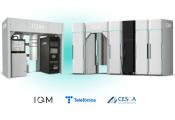LuxQuanta Collaborates in Test of Low Latency Fibre in Data Centers, Led by Lyntia
October 11, 2024 -- LuxQuanta has teamed up with Nokia, LuxQuanta, IDQ, evolutionQ, OFS| Furukawa Solutions and Digital Realty to promote innovation in the telecommunications sector in this proof of concept lead by Lyntia.
Industry-leading companies have teamed up to conduct a proof of concept of quantum cryptography systems also known as Quantum Key Distribution (QKD) in a real-world data centre production network environment. The goal was clear: to secure a fibre-optic link from Digital Realty's data centre and, in turn, to demonstrate on one leg of the connection the compatibility of quantum cryptography with a new, very low-latency fibre-optic technology.
Currently, the transmission of information is predominantly protected by asymmetric encryption protocols based on mathematical algorithms such as number factorization problems. However, advancements in machine learning, artificial intelligence, and quantum computing threaten the security of this cryptographic approach. In particular, it is estimated that, in the coming years, quantum computers will be able to break current cryptography based on mathematical problems with relative ease, putting the security of all digital communications of large companies at serious risk.
Two major quantum-safe cryptographic alternatives have been developed to address this security threat: Post-Quantum Cryptography (PQC) and Quantum Key Distribution (QKD). PQC is a software-based solution that employs complex mathematical algorithms to resist quantum computing attacks. However, since it relies on mathematical problems, there remains the possibility that future advancements could eventually solve these, potentially compromising its security.
QKD allows the secure exchange and generation of cryptographic symmetric keys between two locations protecting them by the laws of quantum physics. This physical method does not rely on mathematical algorithms, offering a genuinely future-proof approach to information security which can be used alongside other cryptographic techniques to provide greater defence and resiliency.
Hollow Core & QKD in Data Center Networks
In this test, two versions of QKD technology, from the two manufacturers LuxQuanta (CV-QKD) and ID Quantique (DV-QKD), along with a Quantum Key Management System (QKMS) from evolutionQ, were used to protect data centre access connections. This is a breakthrough for companies in terms of security, introducing this new technology capable of providing cryptographic protection even against quantum computers.
The other major breakthrough of this test is the use of ‘Hollow core’ fibre cable, manufactured by OFS| Furukawa Solutions, in the first connection with the data centre. This innovative fibre was presented a few months ago in another real field test and allows light to travel almost 46% faster than conventional optical fibres, thus reducing transmission latency by more than 30%, which makes it particularly interesting for data centres.
Once the connection between the data centre and the customer is secured with LuxQuanta’s CV-QKD systems using the “Hollow-Core” fibre, a second deployment of QKD systems, in this case from the manufacturer ID Quantique, is made via conventional fibre from lyntia to extend the reach of the connection by several tens of kilometres.
This ambitious collaboration culminates in the seamless integration of Nokia and evolutionQ systems, ensuring effective orchestration of the deployment. Nokia has provided high-capacity, low-latency, and highly available encryption systems utilizing quantum-secure keys to ensure in-flight data confidentiality, alongside its certified geo-redundant Security Management Server (SMS) systems.
By continuously monitoring the Quantum-Safe optical data centre connectivity service, the SMS can automatically ensure quantum-computer-safe connectivity by reverting to classic physics-based keys in the event of DDoS attacks on the QKD layer or failures in both key generation and distribution, resulting in a highly available Quantum-Safe optical data centre connectivity service. Equally crucial is evolutionQ's role in the success of the project. Its key management system, known as BasejumpQDN, ensures efficient management of QKD keys between nodes and manages the delivery of these to Nokia's encryptors at the right time.
In short, this test allows the daisy-chaining of two QKD systems to transmit quantum keys over a longer distance over a production network, allowing to reach longer distances of up to 200 kilometres with just one pair of devices. From now on, it will be possible to carry out this transmission to more datacentres as more equipment is installed.
A proof of concept ahead of the curve
This test offers companies an excellent level of communications security that can be controlled by their own departments and preparing them to solve cyber-security problems for when quantum computing, AI and ML can hack most of today's encryption strategies.
On the one hand, the manufacturers of QKD equipment, the companies LuxQuanta and ID Quantique, the company evolutionQ as QKD integrator, as well as Nokia, which is responsible for the manufacture of DWDM and OFS| Furukawa Solutions, manufacturer of the ‘Hollow Core’ fibre cable. Digital Realty also took part in the trial by providing the data centre that hosted the launch event.
This project anticipates the growing threat facing the cybersecurity of digital communications, serving as an example and a call to action for multiple sectors, especially for data centres. The implementation of new cryptographic security solutions, such as QKD and related technologies, is already a reality.




































